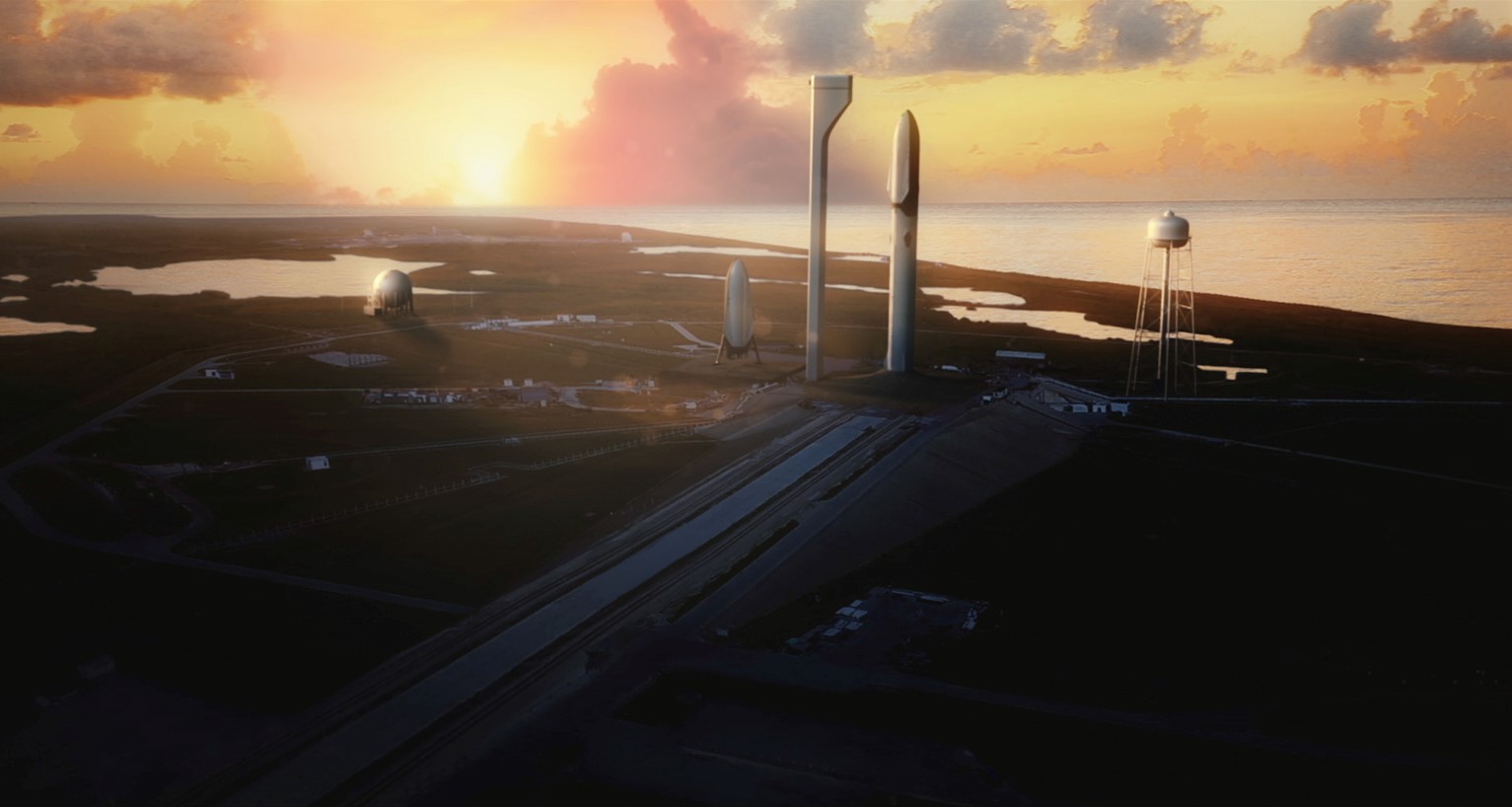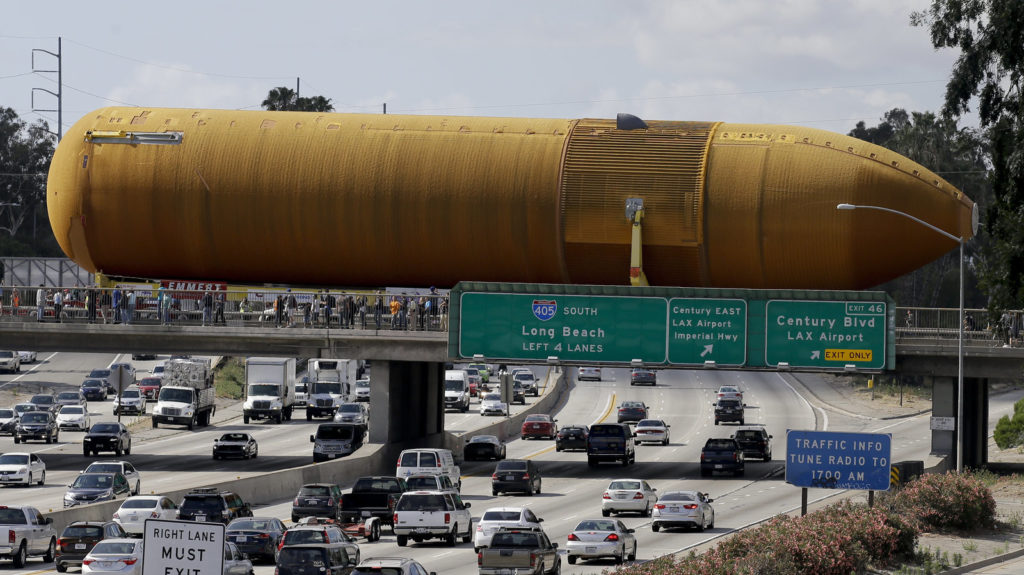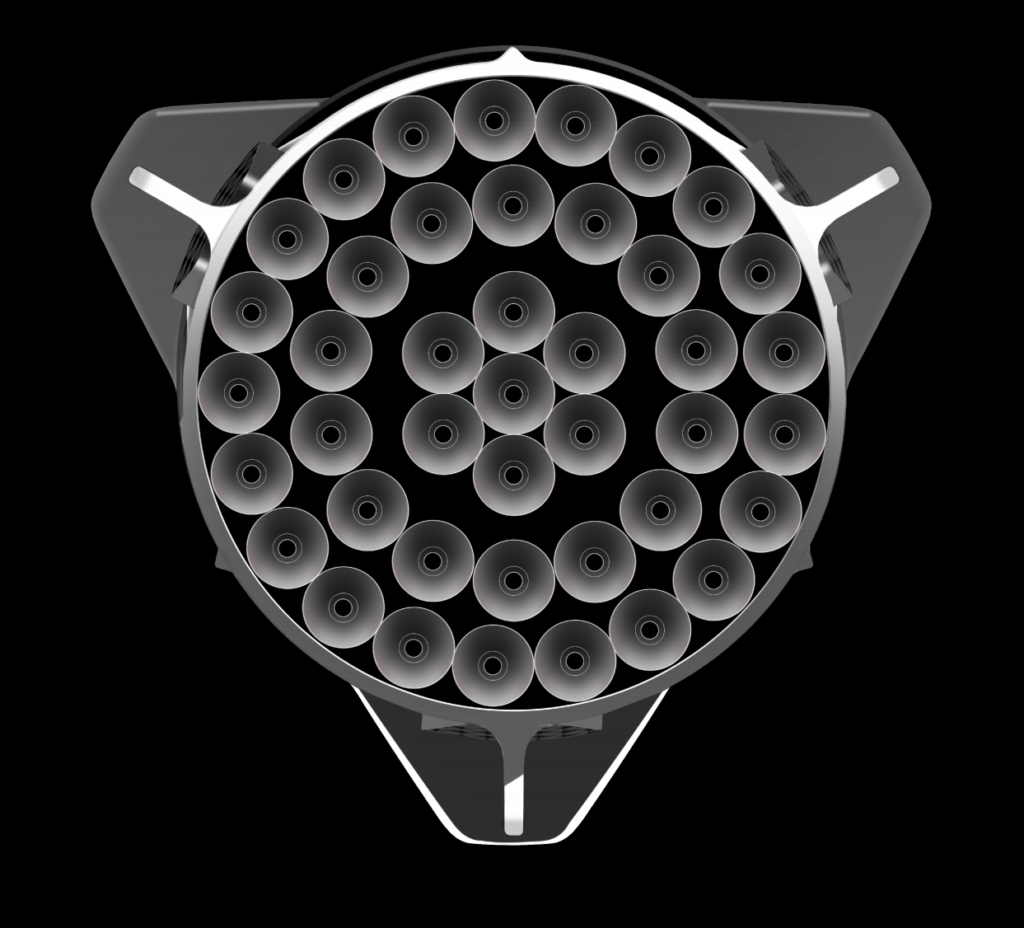

News
SpaceX considers Florida launch pad for both Falcon and Mars vehicle launches
Following a highly informative discussion at the ISS R&D conference, Elon Musk revealed that the updated, leaner version of SpaceX’s Mars architecture would likely have a diameter of around 9 meters.
A 9m Interplanetary Transport System, while precisely 25% smaller than the 12m diameter version revealed last year, would have to either lose the outer ring of full scale Raptor engines, or pivot to a smaller version of Raptor in order to preserve the 42 engine configuration shown at the IAC. Given Musk’s adamant and harsh judgement of the complexity of 27 Merlin 1D engines simultaneously firing on Falcon Heavy, moving to a 21 engine first stage for SpaceX’s Mars vehicle is a fair bet, so long as the full scale Raptor engine is still planned. Extremely speculative calculations based on the limited information available suggest that this smaller ITS could launch a bit less than half the payload of the original, still almost double the capability of Saturn V.
- A Space Shuttle’s external tank makes its way through downtown Los Angeles in 2011. The ET had a diameter of 8.4m. (AP/Chris Carlson)
- The base of SpaceX’s ITS booster, circa 2016. Current plans make it likely that the outside ring of engines will be subtracted and the vehicle made leaner. (SpaceX)
Possibly the most significant information to come out of this tweet is the implication that SpaceX and Musk are now looking to utilize current manufacturing facilities for the construction of a smaller ITS. While it adds considerable expense, the transport of a Space Shuttle’s external fuel tank through the streets of Los Angeles in 2011 sets a precedent for it being possible for SpaceX to transport a 9m vehicle from its factory in Hawthorne, CA to a nearby port. If SpaceX is able to use the same facilities it currently has for developing its Mars vehicle, it would experience immense savings compared to the cost of developing entirely new factories and testing facilities. This matches up perfectly with Musk’s repeated statement that the updated ITS is focused on improving the economic case for the vehicle and making it significantly cheaper to develop.
A 9m diameter vehicle fits in our existing factories …
— Elon Musk (@elonmusk) July 22, 2017
Possibly the most crucial keystone of this economical update relates to the launch pad or pads that will be necessary to launch a rocket as large as either ITS. An oft-overlooked feature of the current LC-39A launch pad SpaceX leases and operates in Florida is that it and its LC-39B sibling were developed with a far larger and more powerful version of Saturn V in mind, known as Nova at the time. SpaceX is well aware of this, and is also painfully aware of just how expensive the construction of launch pads can be after having to undertake deep repairs of LC-40.

Mockups of potential solutions for a dual vehicle setup at LC-39A. With this arrangement, SpaceX would be able to continue crewed and Falcon Heavy launches from the pad while conducting initial tests and launches of their ITS. (Jay Deshetler, in addition to Cameron Byers and John Archer, based on notes from KSC pad engineers)(NASASpaceflight)
Buried in a fascinating article by Chris Bergin of NASASpaceflight.com fame, Bergin has revealed that documents and rumblings behind the scenes indicate that SpaceX is seriously considering either co-launching from LC-39B or modifying LC-39A with a second launch mount. This would require considerably modifications to the venerable pad, but it would not require the costly and time-consuming construction of an entirely new launch pad. Speculative renders and mockups (above) created by the skilled forum members of NASASpaceflight demonstrate this nicely, showing the launch mount for ITS and Falcon side by side.
Combined with Musk’s past statements about this updated version of ITS, the future is looking increasingly bright for what was initially a somewhat crazy architecture. Easier transport, recycled development facilities, and co-location on an already-constructed launch pad show that SpaceX are completely serious about their ambitions for Mars and are willing to do what is necessary to get to the Moon, the Red Planet, and beyond.
News
These Tesla, X, and xAI engineers were just poached by OpenAI
The news is the latest in an ongoing feud between Elon Musk and the Sam Altman-run firm OpenAI.

OpenAI, the xAI competitor for which Elon Musk previously served as a boardmember and helped to co-found, has reportedly poached high-level engineers from Tesla, along with others from xAI, X, and still others.
On Tuesday, Wired reported that OpenAI hired four high-level engineers from Tesla, xAI, and X, as seen in an internal Slack message sent by co-founder Greg Brockman. The engineers include Tesla Vice President of Software Engineering David Lau, X and xAI’s head of infrastructure engineering Uday Ruddarraju, and fellow xAI infrastructure engineer Mike Dalton. The hiring spree also included Angela Fan, an AI researcher from Meta.
“We’re excited to welcome these new members to our scaling team,” said Hannah Wong, an OpenAI spokesperson. “Our approach is to continue building and bringing together world-class infrastructure, research, and product teams to accelerate our mission and deliver the benefits of AI to hundreds of millions of people.”
Lau has been in his position as Tesla’s VP of Software Engineering since 2017, after previously working for the company’s firmware, platforms, and system integration divisions.
“It has become incredibly clear to me that accelerating progress towards safe, well-aligned artificial general intelligence is the most rewarding mission I could imagine for the next chapter of my career,” Lau said in a statement to Wired.
🚨Optimistic projections point to xAI possibly attaining profitability by 2027, according to Bloomberg's sources.
If accurate, this would be quite a feat for xAI. OpenAI, its biggest rival, is still looking at 2029 as the year it could become cash flow positive.💰 https://t.co/pE5Z9daez8
— TESLARATI (@Teslarati) June 18, 2025
READ MORE ON OPENAI: Elon Musk’s OpenAI lawsuit clears hurdle as trial looms
At xAI, Ruddarraju and Dalton both played a large role in developing the Colossus supercomputer, which is comprised of over 200,000 GPUs. One of the major ongoing projects at OpenAI is the company’s Stargate program,
“Infrastructure is where research meets reality, and OpenAI has already demonstrated this successfully,” Ruddarraju told Wired in another statement. “Stargate, in particular, is an infrastructure moonshot that perfectly matches the ambitious, systems-level challenges I love taking on.”
Elon Musk is currently in the process of suing OpenAI for shifting toward a for-profit model, as well as for accepting an investment of billions of dollars from Microsoft. OpenAI retaliated with a counterlawsuit, in which it alleges that Musk is interfering with the company’s business and engaging in unfair competition practices.
Elon Musk confirms Grok 4 launch on July 9 with livestream event
News
SpaceX share sale expected to back $400 billion valuation
The new SpaceX valuation would represent yet another record-high as far as privately-held companies in the U.S. go.

A new report this week suggests that Elon Musk-led rocket company SpaceX is considering an insider share sale that would value the company at $400 billion.
SpaceX is set to launch a primary fundraising round and sell a small number of new shares to investors, according to the report from Bloomberg, which cited people familiar with the matter who asked to remain anonymous due to the information not yet being public. Additionally, the company would sell shares from employees and early investors in a follow-up round, while the primary round would determine the price for the secondary round.
The valuation would represent the largest in history from a privately-owned company in the U.S., surpassing SpaceX’s previous record of $350 billion after a share buyback in December. Rivaling company valuations include ByteDance, the parent company of TikTok, as well as OpenAI.
Bloomberg went on to say that a SpaceX representative didn’t respond to a request for comment at the time of publishing. The publication also notes that the details of such a deal could still change, especially depending on interest from the insider sellers and share buyers.
Axiom’s Ax-4 astronauts arriving to the ISS! https://t.co/WQtTODaYfj
— TESLARATI (@Teslarati) June 26, 2025
READ MORE ON SPACEX: SpaceX to decommission Dragon spacecraft in response to Pres. Trump war of words with Elon Musk
SpaceX’s valuation comes from a few different key factors, especially including the continued expansion of the company’s Starlink satellite internet company. According to the report, Starlink accounts for over half of the company’s yearly revenue. Meanwhile, the company produced its 10 millionth Starlink kit last month.
The company also continues to develop its Starship reusable rocket program, despite the company experiencing an explosion of the rocket on the test stand in Texas last month.
The company has also launched payloads for a number of companies and government contracts. In recent weeks, SpaceX launched Axiom’s Ax-4 mission, sending four astronauts to the International Space Station (ISS) for a 14-day stay to work on around 60 scientific experiments. The mission was launched using the SpaceX Falcon 9 rocket and a new Crew Dragon capsule, while the research is expected to span a range of fields including biology, material and physical sciences, and demonstrations of specialized technology.
News
Tesla Giga Texas continues to pile up with Cybercab castings
Tesla sure is gathering a lot of Cybercab components around the Giga Texas complex.

Tesla may be extremely tight-lipped about the new affordable models that it was expected to start producing in the first half of the year, but the company sure is gathering a lot of Cybercab castings around the Giga Texas complex. This is, at least, as per recent images taken of the facility.
Cybercab castings galore
As per longtime drone operator Joe Tegtmeyer, who has been chronicling the developments around the Giga Texas complex for several years now, the electric vehicle maker seems to be gathering hundreds of Cybercab castings around the factory.
Based on observations from industry watchers, the drone operator appears to have captured images of about 180 front and 180 rear Cybercab castings in his recent photos.
Considering the number of castings that were spotted around Giga Texas, it would appear that Tesla may indeed be preparing for the vehicle’s start of trial production sometime later this year. Interestingly enough, large numbers of Cybercab castings have been spotted around the Giga Texas complex in the past few months.
Cybercab production
The Cybercab is expected to be Tesla’s first vehicle that will adopt the company’s “unboxed” process. As per Tesla’s previous update letters, volume production of the Cybercab should start in 2026. So far, prototypes of the Cybercab have been spotted testing around Giga Texas, and expectations are high that the vehicle’s initial trial production should start this year.
With the start of Tesla’s dedicated Robotaxi service around Austin, it might only be a matter of time before the Cybercab starts being tested on public roads as well. When this happens, it would be very difficult to deny the fact that Tesla really does have a safe, working autonomous driving system, and it has the perfect vehicle for it, too.
-

 Elon Musk1 week ago
Elon Musk1 week agoTesla investors will be shocked by Jim Cramer’s latest assessment
-

 News2 weeks ago
News2 weeks agoTesla Robotaxi’s biggest challenge seems to be this one thing
-

 Elon Musk1 day ago
Elon Musk1 day agoElon Musk confirms Grok 4 launch on July 9 with livestream event
-

 News2 weeks ago
News2 weeks agoWatch the first true Tesla Robotaxi intervention by safety monitor
-

 News5 days ago
News5 days agoTesla Model 3 ranks as the safest new car in Europe for 2025, per Euro NCAP tests
-

 Elon Musk2 weeks ago
Elon Musk2 weeks agoA Tesla just delivered itself to a customer autonomously, Elon Musk confirms
-

 Elon Musk2 weeks ago
Elon Musk2 weeks agoxAI welcomes Memphis pollution results, environmental groups push back
-

 Elon Musk2 weeks ago
Elon Musk2 weeks agoElon Musk confirms Tesla Optimus V3 already uses Grok voice AI

















